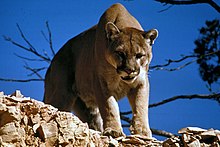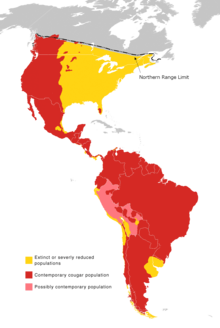
Back Poema Afrikaans የተራራ አንበሣ Amharic Puma concolor AN Beorglēo ANG أسد الجبال Arabic اسد الجبال ARZ Puma concolor AST Пума AV Wasol (Puma concolor) AVK Puma Azerbaijani
| Cougar Temporal range: Early Pleistocene – Holocene
| |
|---|---|

| |
| A North American cougar in Glacier National Park, United States | |
| Scientific classification | |
| Domain: | Eukaryota |
| Kingdom: | Animalia |
| Phylum: | Chordata |
| Class: | Mammalia |
| Order: | Carnivora |
| Suborder: | Feliformia |
| Family: | Felidae |
| Subfamily: | Felinae |
| Genus: | Puma |
| Species: | P. concolor
|
| Binomial name | |
| Puma concolor | |
| Subspecies | |
|
Also see text | |

| |
| Cougar range (without recent confirmations across northern Canadian territories, eastern U.S. states, and Alaska) | |
The cougar (Puma concolor) (/ˈkuːɡər/, KOO-gər), also known as the panther, mountain lion, catamount and puma, is a large cat native to the Americas. It inhabits North, Central and South America, making it the most widely distributed wild, terrestrial mammal in the Western Hemisphere, and one of the most widespread in the world. Its range spans the Canadian Territory of Yukon, British Columbia and Alberta provinces, the Rocky Mountains and areas in the Western United States. Further south, its range extends through Mexico to the Amazon Rainforest and the southern Andes Mountains in Patagonia. It is an adaptable, generalist species, occurring in most American habitat types. It prefers habitats with dense underbrush and rocky areas for stalking but also lives in open areas.
The cougar is largely solitary. Its activity pattern varies from diurnality and cathemerality to crepuscularity and nocturnality between protected and non-protected areas, and is apparently correlated with the presence of other predators, prey species, livestock and humans. It is an ambush predator that pursues a wide variety of prey. Ungulates, particularly deer, are its primary prey, but it also hunts rodents. It is territorial and lives at low population densities. Individual home ranges depend on terrain, vegetation and abundance of prey. While large, it is not always the dominant apex predator in its range, yielding prey to other predators. It is reclusive and mostly avoids people. Fatal attacks on humans are rare but increased in North America as more people entered cougar habitat and built farms.
The cougar is listed as Least Concern on the IUCN Red List. Intensive hunting following European colonization of the Americas and ongoing human development into cougar habitat has caused populations to decline in most parts of its historical range. In particular, the eastern cougar population is considered to be mostly locally extinct in eastern North America since the early 20th century, with the exception of the isolated Florida panther subpopulation.
- ^ a b Nielsen, C.; Thompson, D.; Kelly, M. & Lopez-Gonzalez, C. A. (2016) [errata version of 2015 assessment]. "Puma concolor". IUCN Red List of Threatened Species. 2015: e.T18868A97216466. doi:10.2305/IUCN.UK.2015-4.RLTS.T18868A50663436.en. Retrieved January 16, 2022.
- ^ Cite error: The named reference
MSW3was invoked but never defined (see the help page).
Cite error: There are <ref group=lower-alpha> tags or {{efn}} templates on this page, but the references will not show without a {{reflist|group=lower-alpha}} template or {{notelist}} template (see the help page).
© MMXXIII Rich X Search. We shall prevail. All rights reserved. Rich X Search
